Introduction
Anthropogenic greenhouse gases increase is the major driver of the present and forthcoming climate change. IARC carries out high quality atmospheric greenhouse gases measurements at Izaña observatory (Global GAW station), following WMO GAW recommendations.
To achieve the high quality required for the measurements, IARC has built measurement systems (hardware based on commercial components; acquisition, control, and raw data processing software done by IARC staff) that work in a non-commercial way (achieving much better accuracy). The measurement systems are continuously calibrated (every 15 minutes or 60 minutes depending on the particular system) using working standards made at Izaña using natural air. The working standards are calibrated against the Izaña standards (provided by the WMO GAW Central Calibration Laboratory) every two weeks. Therefore, the measurements are in the WMO scale, and the working standards are traceable to the WMO GAW primary standards.
IARC Greenhouse Gases and Carbon Cycle program deals with the measurement of the main greenhouse gases, but also with carbon monoxide measured with a GC-RGA3 due to: a) the measurement scheme (gas chromatography, and the use of working standards and Izaña standards) is similar to that used with some greenhouse gases, b) carbon monoxide affects the atmospheric burden of methane.

Main Scientific Goals
The main goal of the Greenhouse Gases and Carbon Cycle programme conducted by IARC is to carry out highly accurate atmospheric long-lived greenhouse gas (GHG) in situ continuous measurements at IZO in order to contribute to the GAW-WMO programme, following the GAW recommendations and guidelines. Additional goals are: 1) to study with precision the long-term evolution of the GHGs in the atmosphere, as well as their daily, seasonal and inter- annual variability; 2) To incorporate continuously technical instrumental improvements and new data evaluation and calibration methodologies in order to reduce uncertainty and improve the accuracy of the GHG measurements; 3) to carry out research to study the processes that control the variability and evolution of the GHGs in the atmosphere; and 4) to contribute to international research and its documentation via recommendations and guidelines.
In addition, since 2017 there has been a growing demand to provide reliable near real time GHG data for data assimilation by atmospheric models, to study the impact of certain large-scale phenomena (e.g. large wild fires), to exchange data with the remote sensing community, and to inform policy makers since GHG information is now an object of great social interest and great media impact. This new paradigm demands an enormous effort and a technical challenge by having to combine the classic evaluation of very precise background data (a task that can take at least 6 months) with the delivery of data of an acceptable quality and minimally validated within a few hours or minutes of being obtained. These new tasks must be incorporated with the same team of technicians and researchers.
IARC Measurement Programmes
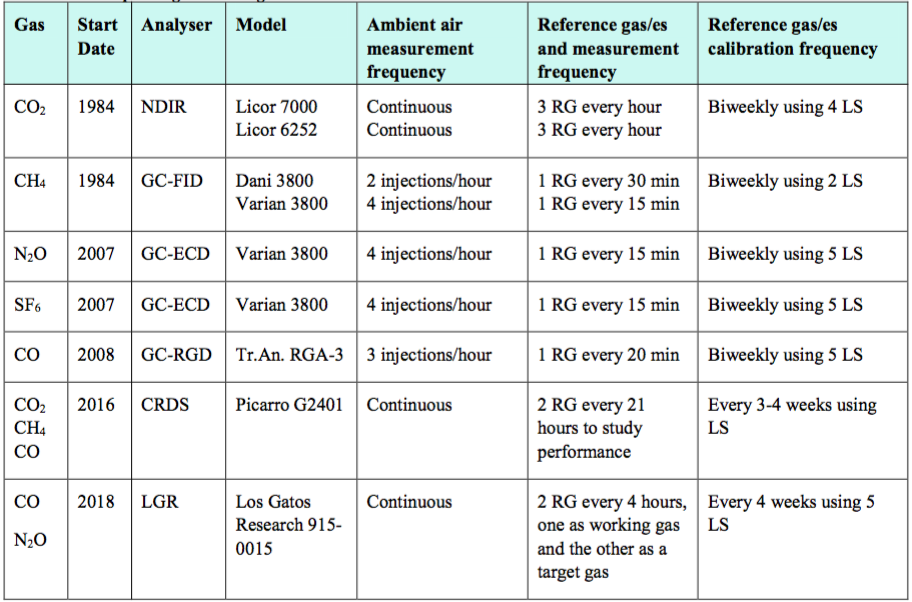
Table 1: Details of the atmospheric greenhouse gases measurements currently performed at IZO using in situ analysers (owned by AEMET) and some details about the measurement schemes.
Additionally, weekly discrete flask samples have been collected for the National Oceanic and Atmospheric Administration-Earth System Research Laboratory-Global Monitoring Division Carbon Cycle Greenhouse Gases Group (NOAA-ESRL-GMD CCGG) Cooperative Air Sampling Network (since 1991). The participation consists of weekly discrete flask sample collection at IZO and subsequent shipping of the samples to NOAA-ESRL-GMD CCGG.
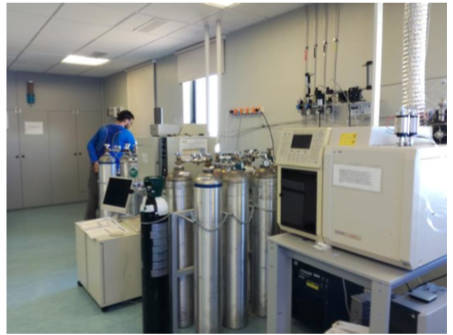
Gas Chromatograph measurement system for CH4, N2O and SF6
The air inside the flasks has been measured for the following gas specie mole fractions: 1) CO2, CH4, CO, and H2 since 1991; N2O and SF6 since 1997 (both sets measured by NOAA/ESRL/GMD CCGG); 2) Isotopic ratios Carbon- 13/Carbon-12 and Oxygen-18/Oxygen-16 in carbon dioxide since 1991 (measured by the Stable Isotope Lab of INSTAAR); 3) Methyl chloride, benzene, toluene, ethane, ethene, propane, propene, i-butane, n-butane, i-pentane, n- pentane, n-hexane and isoprene since 2006 (measured by INSTAAR)
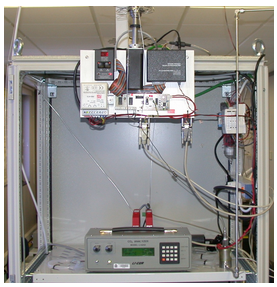
The main part of the measurement system is a NDIR analyser (Siemens Ultramat 3 from 1984 to 2006; LI-COR Li-7000 from 2007 till present, working simultaneously with a LI-COR Li-6252 from 2008 till present). Upstream of the NDIR, a cryocool trap is used to reduce the dew point of ambient air to -65 C.
Between calibrations, ambient air is analysed continuously and raw data are stored. Physical data are obtained using the instrument calibrations performed using 3 working standards.
In situ measurement of Methane since 1984 using GC-FIDs
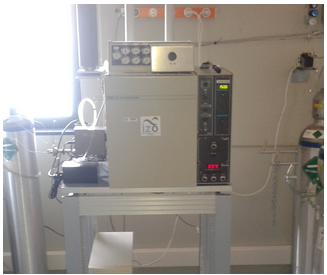
The main part of the measurement system is a gas chromatograph GC-3800 DANI with a flame ionization detector (FID). Upstream of the GC sample loop (10 ml size), a cryocool trap is used to reduce the dew point of ambient air to -65 C. The instrument is calibrated every 30 minutes using a working gas tank (at minutes 15 and 45 every hour). The working gas tank is calibrated every two weeks against the methane Izana standards (provided by WMO GAW CH4 CCL). Four samples are automatically measured every hour: at 00 and 30 minutes the sample is ambient air, at 15 and 45 minutes the sample is working gas. Physical data for each ambient air injection are obtained using the two bracketing instrument calibrations (injections of working gas).
Additionally, there is a GC-FID Varian in operation.
In situ measurement of Nitrous Oxide and Sulphur Hexafluoride since 2007 using a GC-ECD
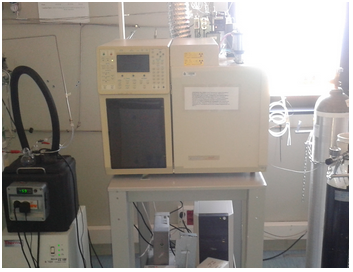
In situ continuous measurement of CO2, CH4 and CO since 2016 using a CRDS spectrometer

Infrastructures
The two general ambient air inlets which provide ambient air for all instruments that analyse it, are 8cm inner diameter (ID) stainless steel pipes, and have a high flow rate. These inlets are situated on top of the building tower; the height above the ground has changed through the years: 13 m (1984-2000), 8 m (2000- May 2005) and 30 m (from June 2005). The measurement systems for greenhouse gases and carbon monoxide are located in two laboratories on the third floor of the Izaña Observatory tower.
Collaborative Measurement Programmes
Since 1991, IARC collects weekly ambient air in a pair of flasks for the NOAA/ESRL/GMD CCGG Cooperative Air Sampling Network. NOAA/ESRL/GMD/CCGG analyses in these samples the mixing ratio of carbon dioxide (and its stable isotope ratios), methane, carbon monoxide, hydrogen, nitrous oxide, sulphur hexafluoride, and recently, some more trace gases.
Since 1984, IARC collects carbon dioxide samples (using a sodium hydroxide solution) for the Carbon Cycle Group, Institut für Umweltphysik, University of Heidelberg. They analyse such samples for the radioactive isotope carbon 14.
Some External Links with IARC Contribution
After processing and quality controlling, IARC greenhouse gases data are submitted to the WMO GAW World Data Center for Greenhouse Gases (WDCGG).
Also, IARC contributes to the products GLOBALVIEW-CO2, GLOBALVIEW-CH4 and OBSPACK.
IARC contributes to the computation of the CO2 surface fluxes carried out by the Max-Planck Institute of Jena, those carried out by NOAA (CarbonTracker) and those carried out by the Wageningen University (CarbonTracker Europe).
IARC contributes to the computation of CO2 global distribution that carries out the Japan Meteorological Agency using an inversion model.
GAW Scientific Audits
Methane, Carbon Monoxide, Nitrous Oxide and Carbon Dioxide Audit (EMPA, September 2013) (download pdf)
Methane and Carbon monoxide Audit (EMPA, March 2009) (download pdf)
Nitrous Oxide Audit (Dr Eckhart Scheel, WCC-N2O, November 2008) (download pdf)
Methane and Carbon monoxide Audit (EMPA, December 2004) (download pdf)
Publications
Yuan, Y., Ries, L., Petermeier, H., Steinbacher, M., Gómez-Peláez, A. J., Leuenberger, M. C., Schumacher, M., Trickl, T., Couret, C., Meinhardt, F., and Menzel, A.: Adaptive Baseline Finder, a statistical data selection strategy to identify atmospheric CO2 baseline levels and its application to European elevated mountain stations, Atmos. Meas. Tech. Discuss., https://doi.org/10.5194/amt-2017-316, in review, 2017.
Gomez-Pelaez, A.J., R. Ramos, V. Gomez-Trueba, E. Cuevas, E. Reyes; “CO2, CH4, and CO with CRDS technique at the Izaña Global GAW station: instrumental tests, developments and first measurement results” presented at “19th WMO/IAEA Meeting on Carbon Dioxide, Other Greenhouse Gases, and Related Measurement Techniques (GGMT-2017)”, Dubendorf, Switzerland, August 27–31, 2017 ”
Shirai, T., M. Ishizawa, R. Zhuravlev, A. Ganshin, D. Belikov, M. Saito, T. Oda, V. Valsala, A.J. Gomez-Pelaez, R. Langenfelds, and S. Maksyutov; A decadal inversion of CO2 using the Global Eulerian–Lagrangian Coupled Atmospheric model (GELCA): sensitivity to the ground-based observation network, Tellus B: Chemical and Physical Meteorology, Vol. 69 , Iss. 1, 2017
Tsuruta, A., Aalto, T., Backman, L., Hakkarainen, J., van der Laan-Luijkx, I. T., Krol, M. C., Spahni, R., Houweling, S., Laine, M., Dlugokencky, E., Gomez-Pelaez, A. J., van der Schoot, M., Langenfelds, R., Ellul, R., Arduini, J., Apadula, F., Gerbig, C., Feist, D. G., Kivi, R., Yoshida, Y., and Peters, W.: Global methane emission estimates for 2000–2012 from CarbonTracker Europe-CH4 v1.0, Geosci. Model Dev., 10, 1261-1289, doi:10.5194/gmd-10-1261-2017, 2017.
Dalsøren, S. B., Myhre, C. L., Myhre, G., Gomez-Pelaez, A. J., Søvde, O. A., Isaksen, I. S. A., Weiss, R. F., and Harth, C. M.: Atmospheric methane evolution the last 40 years, Atmos. Chem. Phys., 16, 3099-3126, doi:10.5194/acp-16-3099-2016, 2016 (link to the paper)
Belikov, D. A., Maksyutov, S., Yaremchuk, A., Ganshin, A., Kaminski, T., Blessing, S., Sasakawa, M., Gomez-Pelaez, A. J., and Starchenko, A.: Adjoint of the global Eulerian–Lagrangian coupled atmospheric transport model (A-GELCA v1.0): development and validation, Geosci. Model Dev. , 9, 749-764, doi:10.5194/gmd-9-749-2016 , 2016. (Link to the paper)
García, O. E., Sepúlveda, E., Schneider, M., Hase, F., August, T., Blumenstock, T., Kühl, S., Munro, R., Gómez-Peláez, Á. J., Hultberg, T., Redondas, A., Barthlott, S., Wiegele, A., González, Y., and Sanromá, E.: Consistency and quality assessment of the Metop-A/IASI and Metop-B/IASI operational trace gas products (O3, CO, N2O, CH4, and CO2) in the subtropical North Atlantic, Atmos. Meas. Tech., 9, 2315-2333, doi:10.5194/amt-9-2315-2016, 2016.
Gomez-Pelaez, A.J., R. Ramos, V. Gomez-Trueba, R. Campo-Hernandez, E. Reyes-Sanchez: “GGMT-2015 Izaña station update: instrumental and processing software developments, scale updates, aircraft campaign, and plumbing design for CRDS” in GAW report (No. 229) of the “18th WMO/IAEA Meeting on Carbon Dioxide, Other Greenhouse Gases, and Related Measurement Techniques (GGMT) (La Jolla, CA, USA, 13-17 September, 2015)”, edited by P. Tans and C. Zellweger, World Meteorological Organization, 125-131, 2016. (Download pdf).
Gomez-Pelaez, A.J., R. Ramos, V. Gomez-Trueba, R. Campo-Hernandez,E. Reyes-Sanchez: “Izaña Global GAW station greenhouse-gas measurement programme. Novelties and developments during October 2011-May 2013” in GAW report (No. 213) of the “17th WMO/IAEA Meeting on Carbon Dioxide, Other Greenhouse Gases, and Related Measurement Techniques (Beijing, China, June 10-14, 2013)”, edited by P. Tans and C. Zellweger, World Meteorological Organization, 77-82, 2014 (Link to the paper).
Sepúlveda, E., Schneider, M., Hase, F., Barthlott, S., Dubravica, D., García, O. E., Gomez-Pelaez, A., González, Y., Guerra, J. C., Gisi, M., Kohlhepp, R., Dohe, S., Blumenstock, T., Strong, K., Weaver, D., Palm, M., Sadeghi, A., Deutscher, N. M., Warneke, T., Notholt, J., Jones, N., Griffith, D. W. T., Smale, D., Brailsford, G. W., Robinson, J., Meinhardt, F., Steinbacher, M., Aalto, T., and Worthy, D.: Tropospheric CH4 signals as observed by NDACC FTIR at globally distributed sites and comparison to GAW surface in situ measurements, Atmos. Meas. Tech., 7, 2337-2360, doi:10.5194/amt-7-2337-2014, 2014 (link to the paper)
Gomez-Pelaez, A. J., Ramos, R., Gomez-Trueba, V., Novelli, P. C., and Campo-Hernandez, R.: A statistical approach to quantify uncertainty in carbon monoxide measurements at the Izaña global GAW station: 2008–2011, Atmos. Meas. Tech., 6, 787-799, doi:10.5194/amt-6-787-2013, 2013 (link to the article)
Sepúlveda, E., M. Schneider, F. Hase, O. E. García, A. Gomez-Pelaez, S. Dohe, T. Blumenstock, and J.C. Guerra, Long-term validation of tropospheric column-averaged CH4 mole fractions obtained by mid-infrared ground-based FTIR spectrometry, Atmos. Meas. Tech., 5, 1425-1441, doi:10.5194/amt-5-1425-2012, 2012 ( link to the article)
Gomez-Pelaez, A.J., R. Ramos, V. Gomez-Trueba, R. Campo-Hernandez, E. Dlugokencky, T. Conway “New improvements in the Izaña (Tenerife, Spain) global GAW station in-situ greenhouse gases measurement program” in GAW report (No. 206) of the “16th WMO/IAEA Meeting on Carbon Dioxide, Other Greenhouse Gases, and Related Measurement Techniques (GGMT-2011) (Wellington, New Zealand, 25-28 October 2011)”, edited by Gordon Brailsford, World Meteorological Organization, 76-81, 2012 (link to the paper)
Chevallier, F., N. M. Deutscher, T. J. Conway, P. Ciais, L. Ciattaglia, S. Dohe, M. Fröhlich, A.J. Gomez-Pelaez, D. Griffith, F. Hase, L. Haszpra, P. Krummel, E. Kyrö, C. Labuschagne, R. Langenfeld, T. Machida, F. Maignan, H. Matsueda, I. Morino, J. Notholt, M. Ramonet, Y. Sawa, M. Schmidt, V. Sherlock, P. Steele, K. Strong, R. Sussmann, P. Wennberg, S. Wofsy, D. Worthy, D. Wunch, M. Zimnoch, Global CO2 fluxes inferred from surface air-sample measurements and from TCCON retrievals of the CO2 total column, Geophysical Research Letters, 38, L24810, doi: 10.1029/2011GL049899, 2011 (link to the article)
Chevallier, F., P. Ciais, T. J. Conway, T. Aalto, B. E. Anderson, P. Bousquet, E. G. Brunke, L. Ciattaglia, Y. Esaki, M. Fröhlich, A. Gomez, A. J. Gomez-Pelaez, L. Haszpra, P. B. Krummel, R. L. Langenfelds, M. Leuenberger, T. Machida, F. Maignan, H. Matsueda, J. A. Morguí, H. Mukai, T. Nakazawa, P. Peylin, M. Ramonet, L. Rivier, Y. Sawa, M. Schmidt, L. P. Steele, S. A. Vay, A. T. Vermeulen, S. Wofsy, D. Worthy, , CO2 surface fluxes at grid point scale estimated from a global 21 year reanalysis of atmospheric measurements, J. Geophys. Res., 115, D21307, doi:10.1029/2010JD013887, 2010.(link to the paper in JGR website).
Gomez-Pelaez, A.J., R. Ramos, E. Cuevas, V. Gomez-Trueba, 25 years of continuous CO2 and CH4 measurements at Izaña Global GAW mountain station: annual cycles and interannual trends; Proceedings of the “Symposium on Atmospheric Chemistry and Physics at Mountain Sites (ACP Symposium 2010, June 8-10, 2010, Interlaken, Switzerland)”, 157-159, 2010 (download pdf)
Levin, I., T. Naegler, B. Kromer, M. Diehl, R. Francey, A. J. Gomez-Pelaez, L. P. Steele, D. Wagenbach, R. Weller, and D.E. Worthy, Observations and modelling of the global distribution and long-term trend of atmospheric 14CO2, Tellus (2010), 62B, 26–46 (download pdf)
Gomez-Pelaez, A.J., Ramos, R., “Improvements in the Carbon Dioxide and Methane Continuous Measurement Programs at Izaña Global GAW Station (Spain) during 2007-2009”, in GAW report (No. 194) of the “15th WMO/IAEA Meeting of Experts on Carbon Dioxide, Other Greenhouse Gases, and Related Tracer Measurement Techniques (Jena, Germany; September 7-10, 2009)”, edited by Willi A. Brand, World Meteorological Organization (TD No. 1553), 133-138, 2011 (download pdf)
Gomez-Pelaez, A.J., Ramos, R., “Installation of a new gas chromatograph at Izaña GAW station (Spain) to measure CH4, N2O, and SF6” in GAW Report (No. 186) of the “14th WMO/IAEA meeting of experts on Carbon dioxide, other greenhouse gases, and related tracers measurement techniques (Helsinki, Finland, 10-13 September 2007)”, edited by Tuomas Laurila, World Meteorological Organization (TD No. 1487), 55-59, 2009 (download pdf)
Gomez-Pelaez, A.J., “A brief overview of the theory of flow along GC packed columns and some practical consequences for measuring atmospheric CH4, N2O, and SF6” in GAW Report (No. 186) of the “14th WMO/IAEA meeting of experts on carbon dioxide, other greenhouse gases, and related tracers measurement techniques (Helsinki, Finland, 10-13 September 2007)”, edited by Tuomas Laurila, World Meteorological Organization (TD No. 1487), 60-64, 2009 (download pdf)
Masarie, K., Tans, P., Andrews, A., Conway, T., Crotwell, A., Worthy, D., Gomez, A.,”NOAA Comparison activities: Are we closer to the required measurement accuracy?” in GAW Report (No. 186) of the “14th WMO/IAEA meeting of experts on Carbon dioxide, other greenhouse gases, and related tracers measurement techniques (Helsinki, Finland, 10-13 September 2007)”, edited by Tuomas Laurila, World Meteorological Organization (TD No. 1487), 33-39, 2009
Patra, P. K., M. Takigawa, K. Ishijima, B.-C. Choi, D. Cunnold, E. J. Dlugokencky, P. Fraser, A. J. Gomez-Pelaez, T.-Y. Goo, J.-S. Kim, P. Krummel, R. Langenfelds, F. Meinhardt, H. Mukai, S. O’Doherty, R. G. Prinn, P. Simmonds, P. Steele, Y. Tohjima, K. Tsuboi, K. Uhse, R. Weiss, D. Worthy and T. Nakazawa, Growth rate, seasonal, synoptic, diurnal variations and budget of methane in lower atmosphere, J. Meteorol. Soc. Jpn., 87(4), 635-663, 2009. (Copyright MSJ). Download pdf.
World Meteorological Organization, “Guidelines for the measurement of methane and nitrous oxide and their quality assurance”, GAW Report No. 185 (WMO/TD – No. 1478), 2009. List of contributors and reviewers: Butler, J.H., Dlugokencky, E., Gomez-Pelaez, A.J., Hall, B., Jordan, A., Klausen, J., Leer, E.d., Scheel, H.E., Steinbrecher, R., Tarasova, O.A., Wielgosz, R.
Gomez-Pelaez, A.J., Ramos, R., Perez-delaPuerta, J., “Methane and carbon dioxide continuous measurements at Izana GAW station (Spain)” in GAW Report (No. 168) of the “13th WMO/IAEA Meeting of Experts on Carbon Dioxide Concentration and Related Tracers Measurement Techniques
(Boulder, Colorado, USA, 19-22 September 2005)”, edited by J.B. Miller, World Meteorological Organization (TD No. 1359), 180-184, 2006 (download pdf)
Ripodas, P., Ramos, R., Cuevas, E., Calbet, X., “1984-1999 CO2 time series at Izana (Tenerife). Long range transport effects”. Report of the “2 Asamblea Hispano Portuguesa de Geodesia y Geofisica”, Lagos, Portugal, 2000, page. 467.
Staff
Dr Emilio Cuevas (AEMET; new Coordinator of programme)
Pedro Pablo Rivas Soriano (AEMET; Software and data processing)
Ramón Ramos (AEMET; Head of Infrastructure and instrumentation)
Enrique Reyes (AEMET; Software and data processing)
Vanessa Gómez-Trueba (Air Liquide)
